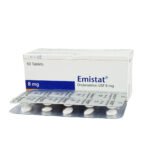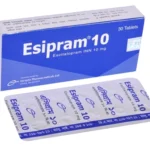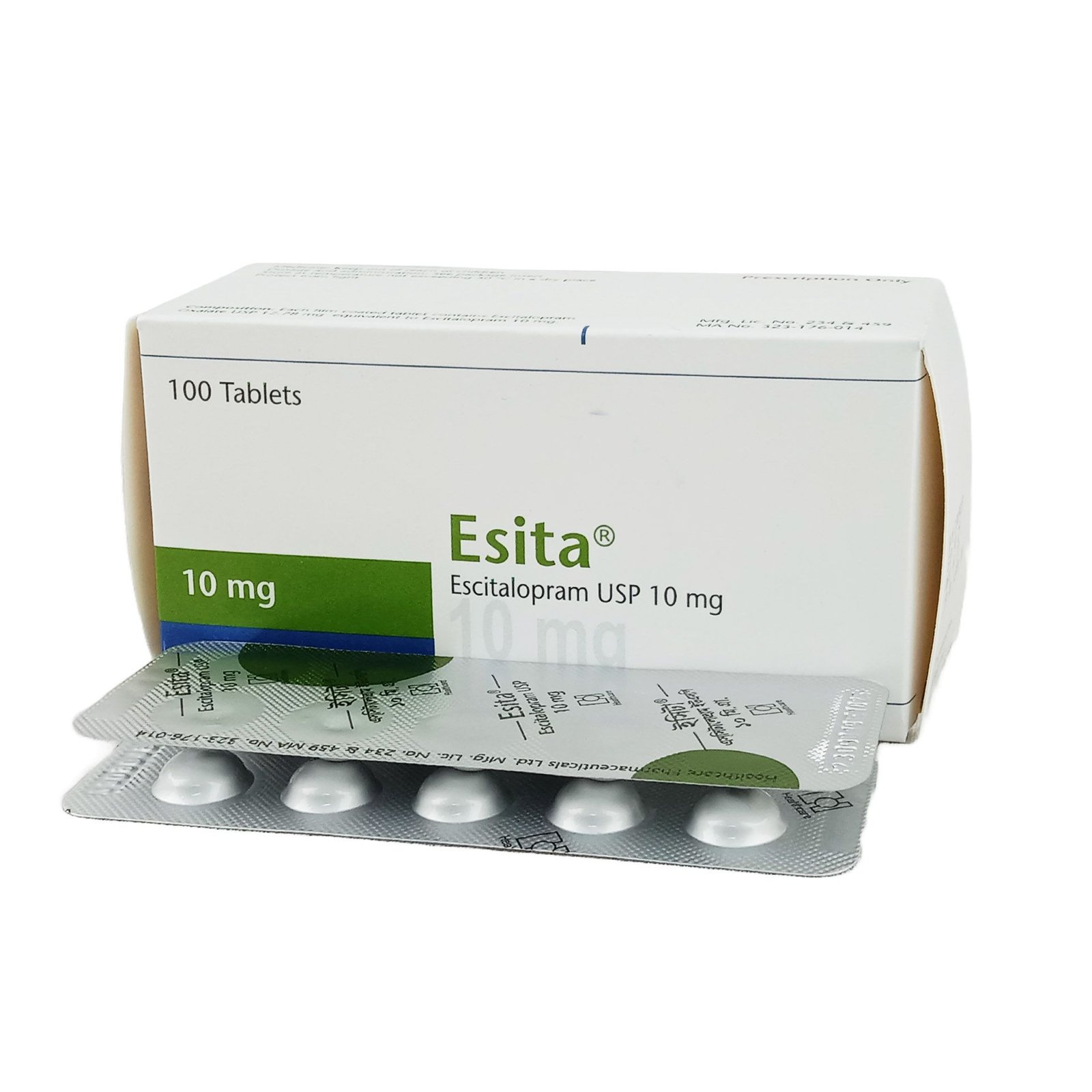Esita 10 mg
Description
Indications
Esita is prescribed for the following conditions:
- Treatment of major depressive episodes
- Treatment of panic disorder, with or without agoraphobia
- Treatment of social anxiety disorder (social phobia)
- Treatment of generalized anxiety disorder
- Treatment of obsessive-compulsive disorder
Take this medication as prescribed by a registered medical professional.
Pharmacology
Escitalopram is a selective serotonin reuptake inhibitor (SSRI) that is taken orally. It is the S-enantiomer of citalopram, a bicyclic phthalate derivative. Escitalopram is significantly more potent than its R-enantiomer (about 100 times more effective) in inhibiting the reuptake of serotonin (5-HT). It has minimal to no affinity for various other receptors, such as adrenergic, dopamine, histamine, muscarinic, or benzodiazepine receptors.
Dosage
Escitalopram is typically administered once daily, either in the morning or evening, with or without food. The usual recommended dosage varies based on the condition being treated:
-
Major Depressive Episodes: Begin with 10 mg daily, which can be increased up to 20 mg daily based on individual response. It may take 2-4 weeks to observe a therapeutic response. After the symptoms resolve, it is recommended to continue treatment for at least 6 months to consolidate the response.
-
Panic Disorder (with or without Agoraphobia): Start with 5 mg daily for the first week, then increase to 10 mg daily. Depending on the patient’s response, the dose can be increased up to 20 mg daily. Maximum effectiveness is typically reached within 3 months, and treatment is usually continued for several months.
-
Social Anxiety Disorder: Start with 10 mg daily. It may take 2-4 weeks for symptom relief, after which the dose may be adjusted to 5 mg or increased to a maximum of 20 mg daily. Long-term treatment (12 weeks or more) is recommended to ensure symptom control and prevent relapse. The condition is chronic, and medication may be continued on an individual basis for long-term management.
-
Generalized Anxiety Disorder: Initial dose is 10 mg daily, which may be increased to a maximum of 20 mg daily depending on individual response. Long-term use has been studied for up to 6 months.
-
Obsessive-Compulsive Disorder (OCD): Begin with 10 mg daily and adjust based on the patient’s response, with a maximum dose of 20 mg daily. OCD is a chronic condition, and ongoing treatment may be necessary for symptom management. Regular evaluation of treatment benefits and dosage adjustments are advised.
Always consult a registered healthcare provider before using this medication.
Administration
Escitalopram should be taken once daily, either in the morning or evening, with or without food.
Follow the advice of a registered healthcare provider when taking this medication.
Interactions
It is essential not to initiate SSRI therapy until at least 2 weeks after stopping a monoamine oxidase inhibitor (MAOI). Likewise, an MAOI should not be started for at least a week after discontinuing an SSRI. For specific drugs, such as paroxetine and sertraline, the gap should be 2 weeks, while for fluoxetine, it should be at least 5 weeks.
Contraindications
Escitalopram is contraindicated in individuals with hypersensitivity to escitalopram, citalopram, or any of the inactive components of the medication. It should not be used in combination with monoamine oxidase inhibitors (MAOIs) or pimozide.
Side Effects
Common side effects of SSRIs include gastrointestinal symptoms (e.g., nausea, vomiting, dyspepsia, abdominal pain, diarrhea, constipation), changes in appetite (either anorexia with weight loss or increased appetite and weight gain), and hypersensitivity reactions (e.g., rash, urticaria, angioedema, anaphylaxis). Other side effects may include dry mouth, nervousness, anxiety, headaches, insomnia, tremors, dizziness, fatigue, hallucinations, convulsions, sexual dysfunction, urinary retention, sweating, and movement disorders. Serious side effects such as serotonin syndrome, convulsions, and visual disturbances can occur in rare cases.
Pregnancy & Lactation
Escitalopram should be used during pregnancy only if absolutely necessary, especially during the third trimester. The drug is excreted in human breast milk, so the decision to continue nursing or to use escitalopram should be carefully considered, weighing the risks to the infant and the benefits to the mother.
Precautions & Warnings
SSRIs, including escitalopram, should be used cautiously in patients with a history of epilepsy (particularly those with poorly controlled seizures), concurrent electroconvulsive therapy (ECT), or a history of mania. Caution is also advised in individuals with cardiac issues, diabetes, glaucoma, a history of bleeding disorders, and hepatic or renal impairments. This medication may increase the risk of bleeding, especially when taken with anticoagulants.
Use in Special Populations
-
Elderly (Over 65 years): The initial dose for elderly patients is 5 mg daily. Depending on the response, the dose may be increased to 10 mg daily.
-
Children & Adolescents (Under 18 years): Escitalopram is not recommended for use in children or adolescents under 18 years old.
-
Renal Impairment: No dose adjustment is necessary for mild to moderate renal impairment. Caution is advised in cases of severe renal dysfunction (CrCl less than 30 ml/min).
-
Hepatic Impairment: For patients with mild or moderate liver impairment, start with 5 mg daily and increase to 10 mg daily based on individual response. In severe hepatic impairment, careful titration is recommended.
-
CYP2C19 Poor Metabolizers: For poor metabolizers of CYP2C19, an initial dose of 5 mg daily is recommended for the first two weeks, which can be increased to 10 mg daily based on response.
Overdose Effects
In case of an overdose, symptoms may include dizziness, tremors, agitation, serotonin syndrome, convulsions, and coma. Gastrointestinal symptoms such as nausea and vomiting, as well as cardiovascular symptoms like hypotension, tachycardia, and QT interval prolongation, may also occur. Management includes symptomatic treatment, gastric lavage, and activated charcoal administration, with monitoring of vital signs and ECG. There is no specific antidote.
Therapeutic Class
Selective serotonin reuptake inhibitors (SSRIs) and related antidepressants.
Storage Conditions
Store below 30°C, away from light and moisture. Keep out of reach of children.
Always follow the instructions of a registered healthcare provider when using Esita.
Additional information
| Weight | 0.15 g |
|---|









Reviews
There are no reviews yet.